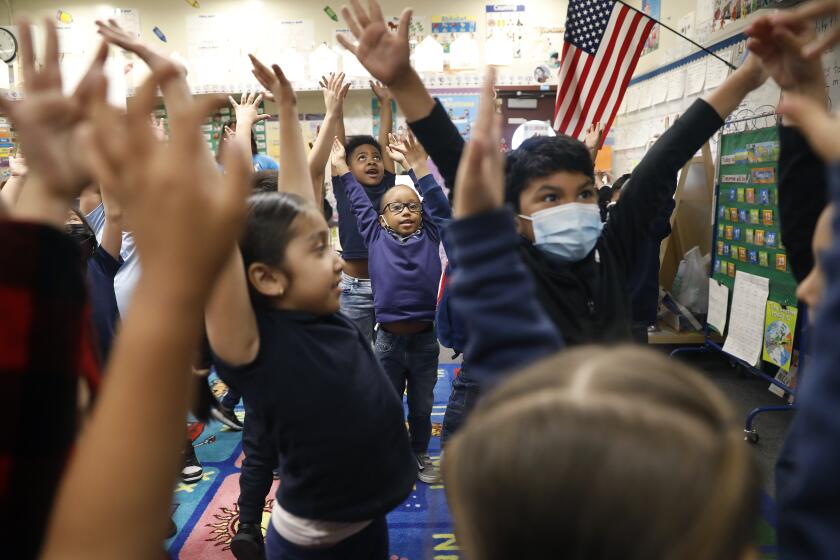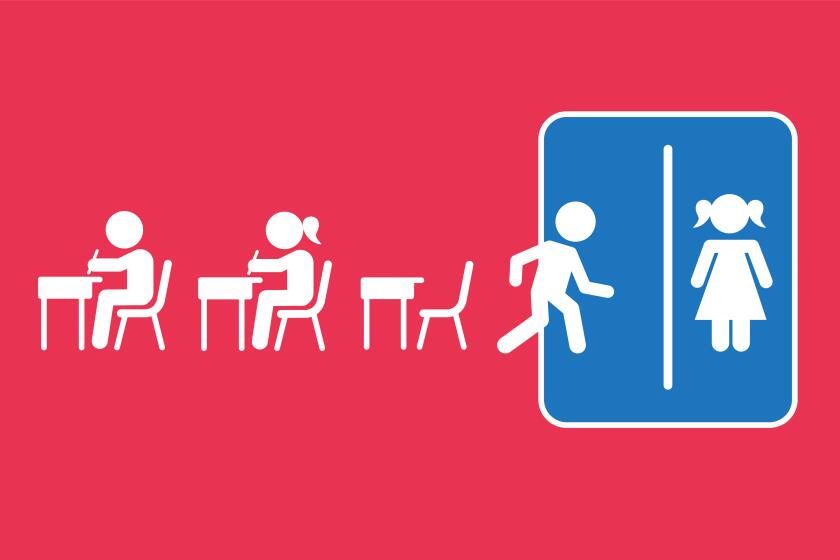‘I don’t want to go to school,’ a child cries. When parents leave here’s what teachers do

- Share via
About 7:45 a.m. the 4-year-olds in Lourdes Serrano’s transitional kindergarten class realized they would be braving their first day of school alone.
“I don’t want to go to school,” one student said tearfully, words that began echoing from other little ones as their parents stood near the door.
“Mommy,” another cried out, joining the chorus of distraught wails echoing around the room.
Half of the class at 135th Street Elementary School in Gardena was in tears as Serrano closed the door.
Bittersweet goodbyes are a rite of passage on the first day of kindergarten. But this year Los Angeles Unified — and schools throughout California — are welcoming more 4-year-old transitional kindergartners, who require extra support.
Here is how teachers are navigating the first days of transitional kindergarten, or TK, as it is commonly called:
As California expands access to transitional kindergarten for all 4-year-olds, districts across the state struggle to recruit and accommodate young learners.
Calming criers
Serrano expects tears to continue through the first week. Once the children begin to understand that their parents will be back for them after the school day ends, it gets easier, she said.
What should parents do? Stay strong and do not linger. That was why, when it was time to head to breakfast after the bell rang, Serrano peeked out the door to make sure the coast was clear of parents. Teachers like Serrano know when to reach out for help. She phoned the office and asked for additional support to help her calm her distraught class.
Joined by an aide and a staff member, they comforted the kids who were having the most difficult time by sitting next to them on the rug or distracting them with a quick puzzle or blocks.
“Most of their anxiety is because they’re not social,” Serrano said. “They’re always at home with mom.”
Serrano created a calming area for her students with mini-couches. When they need to feel more at ease they can go to that part of the classroom and relax with a toy.
Move quickly with activities
The TK classroom at Germain Academy for Academic Achievement was a flurry of squeals as teacher Miriam Bernal and instructional aide Sindy Mai gathered 17 students on a colorful rug decorated with shapes. The teacher turned up the volume of a months-of-the-year song and children were told to settle down on the carpet, but some roamed the classroom; others fidgeted.
“I’m hungry,” one girl cried out. Another started tearing up, clutching Mai’s hand.
The restlessness was similar in Serrano’s classroom. When she pulled out the book “Our Class is a Family” after breakfast, she could barely make it through a few pages because students were jumping to their feet with questions, approaching her for hugs and drowning out her voice with sobs. They transitioned to play instead.
“It’s an adjustment. It’s challenging in the way that they are so young,” said Serrano, who acknowledged that the start of the year mainly revolved around easing that transition to school.
Teachers know to be more patient and take time to observe students. Serrano chose her first classroom activity — story time — to see how long the children could sit still. She is focusing on small group activities at first so kids can get to know one another and on outside play so that they can grow familiar with the campus.
As transitional kindergarten expands across the state, California’s child-care industry is left scrambling to fill empty spots they once depended on.
Minimize potty issues
An important part of the first day? Learning the rules of going to the bathroom.
Run your hands under water, then soap, then water again. Walking, no running. Always close the door. Always flush.
With younger kids entering transitional kindergarten, bathroom accidents are more frequent. Some students can’t wipe themselves completely on their own or are too scared to do so.
California’s 4-year-olds are entering transitional kindergarten. But many young learners aren’t fully potty-trained, an issue public schools are grappling with.
Mai takes students to the bathroom, waiting outside the door for them, but she doesn’t help them. Teachers and aides aren’t equipped to provide toilet help to students.
“Maybe if they need help buttoning their pants, I’ll have them come out of the bathroom and I’ll help them, but that’s it,” she said.
Parents need to work with their children so they are fully potty trained.
This article is part of The Times’ early childhood education initiative, focusing on the learning and development of California children, from birth to age 5. For more information about the initiative and its philanthropic funders, go to latimes.com/earlyed.
More to Read
Sign up for Essential California
The most important California stories and recommendations in your inbox every morning.
You may occasionally receive promotional content from the Los Angeles Times.















